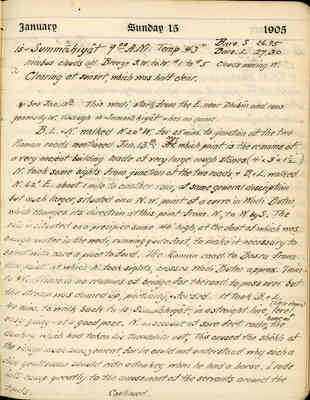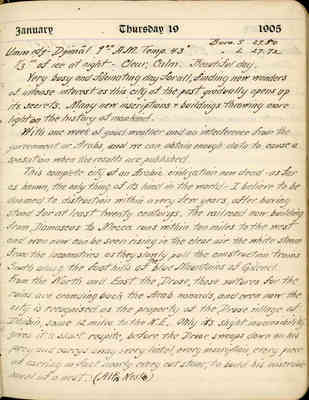Pages That Mention Dhibîn
Norris: Diary, January - May, 1905
BSY_FB_28-015
is-Summāḳiyât 9:00 A.M. Temp. 43 ° Baro. S 26.95 Baro. L. 27.30
nimbus clouds all Breeze S.W. to W. #1 to #5 Clouds moving W. Clearing at sunset, which was half clear.
* See Jan. 12th This wadi starts from the E. near Dhibîn and runs generally W. through is-Summāḳiyât & has no name.
B. L. & N. walked N 20° W. for 25 mins. to junction of the two Roman roads mentioned Jan. 13th. near which point is the remains of a very ancient building made of very large rough stones (4' x 3' x 1 1/2') N. took some sights from junction of the two roads, & B. & L. walked N. 62° E. about 1 mile to another ruin, at same general description but much larger, situated on a N. W. point of a curve in Wadi Butm, which changes its direction at this point from N., to W by S. The ruin is situated on a precipice some 40' high, at the foot of which was enough water in the wadi, running quite fast, to make it necessary to select with care a place to ford. The Roman road to Bosra from the point at which N. took sights, crosses Wadi Butm approx. 7 min. to W. There is no remains of bridge for the road to pass over but the stream was damed up, partially, & forded. It took B. & L. 40 mins. to walk back to is-Summāḳiyât, in a straight line level ^ (little down) ^, easy going - at a good pace. N. on account of sore feet rode ^ home on ^ the donkey which had taken his theodolite out, This caused the shêkh of the village much amazement, for he could not understand why such a fine gentleman should ride a donkey when he had a horse. I rode into camp greatly to the amusement of the servants around the tents.
Continued.
BSY_FB_28-019
Umm idj-Djimâl 9:00 A.M. Temp. 43 ° Baro. S 27.50 " Baro L 27.72 1/3 in of ice at night - Clear, Calm. Beautiful day.
Very busy and fascinating day for all, finding new wonders of intense interest as this city of the past gradually opens up its secrets. Many new inscriptions & buildings throwing more light on the history of mankind.
With one week of good weather and no interference from the government or Arabs, we can obtain enough data to cause a sensation when the results are published.
This complete city of an Arabic civilization now dead - as far as known, the only thing of its kind in the world - I believe to be doomed to distruction? within a very few years, after having stodd for at least twenty centurys?. The railroad now building from Damascus to Mecca runs within ten miles to the west and even now can be seen rising in the clear air the white steam from the locomotives as they slowly pull the construction trains South along the foot hills of the blue Mountains of Gilead. From the North and East the Druse, those vultures for the ruins are crowding the Arab nomads, and even now the city is recognised as the property of the Druse village of Dhibin, some 12 miles to the N.E. Only its slight inaccesibility gives it a short respite, before the Druse swoops down on his prey and carrys? away every lintel, every inscription, every piece of earring in fact nearly every cut stone, to build his miserable hovel of a nest. (Altis Nest)


